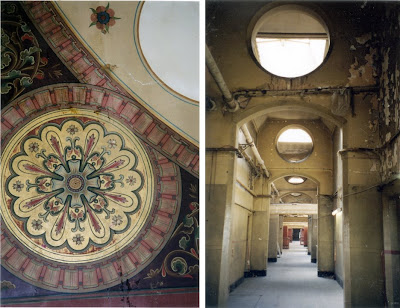




 I read with some envy and wistfulness about the reopening of St. Pancras Station in London (images second row) as the new 'home' of the Eurostar.
I read with some envy and wistfulness about the reopening of St. Pancras Station in London (images second row) as the new 'home' of the Eurostar.Why would I care about a train station in London?
Well, first I am inordinately fond of the city, despite the weather and the fact they charge you for matches, and I haven't been since Fall 2005. Mostly though its because London manages to renovate and repurpose old buildings with flair. I seem to recall coming upon various old piles that had been meaningfully and usefully integrated into modern life (Borough Market, Tate Modern come to mind first). Usually with nice signage, too.
There's something so vigorous and ...heartening... about a sleek, well-planned new transportation station. Somehow it makes you think there are people in government who see the bigger picture. Something like, 'Ah, the city is working. Somebody's manning the deck. good. progress.'
I never feel that in New York.
Work was begun on St. Pancras station in the eponymous parish section of London in the early 1860’s. A working class slum, Agar town, and the churchyard of old St. Pancras were demolished for the construction. Dickens described it in Dombey and Son (as quoted in the Guardian)
Houses were knocked down; streets broken through and stopped; deep pits and trenches dug in the ground; enormous heaps of earth and clay thrown up; buildings that were undermined and shaking, propped by great beams of wood ..."It must have been a ghastly affair. I believe they had to submerge or divert a river (the Fleet). Also, a full 8,000 graves had to be removed from the construction site. Supervisor for the exhumations was a 26-year old architect's assistant from Dorset named Thomas Hardy. Yes, that one.
St. Pancras train station opened in 1868. William Barlow's single-span train shed of iron and glass spans 240 feet and is more than 100 feet high at its apex, and was the largest enclosed space in the world when it was completed.
Adjoining the magnificent station —and acting as its public face—was an imposing and sprawling brick edifice. Designed by George Gilbert Scott in a lavish High Victorian Gothic revival style it opened on May 5th, 1873, as the Midland Grand Hotel. Turreted, balconied, arabesqued and decoratively voussoired to within an inch of its life, the Midland Grand operated until 1935. Thereafter it wheezed through much of the 20th century as the office headquarters of British Transport Hotels. After suffering many indignities of a 1950s vintage, including lowered ceilings, it sat vacant since the 1980s.
I think it was about 2000/01 that I wangled my way into a private but abbreviated walk-through of the place, that was, by that point, called St. Pancras Chambers (see my pre-digital photos 4th row down). Scott (the architect) had designed everything down to the drawer pulls. Embellished and illuminated, it was magnificent in its ponderousness and even more evocative in its ruined deshabille.
The Jefferson Market Library, nee Courthouse, in Greenwich Village, at bottom, is a smaller sibling I would say. I had always thought of it as the only representative of Lean Bacon Revival style in NYC. (photo by steve spak.)
Now St. Pancras Chambers will be a hotel again, and, as is the wont of the capitalist market, "luxury lofts." The firm managing the overhaul, oddly named the Manhattan Loft Company, has created a rather nice and detailed animated timeline of the building in the Ken Burnsian manner.
I'm liking what I see as the logo for the residential project (top). Anyone have info?
It seems now is the renaissance for all things Victorian, no? Refreshing I think.
British architectural historian Sir John Summerson once described the Midland as “nauseating”. And certainly for a good deal of the 20th century "Victorian" was an epithet not given in kindness. An interesting take (on Vulpes Libris ) on why Victorian architecture became so reviled by mid century-- at least in the UK:
At its finest Victorian architecture is bullish, ebullient and self-confident … and perhaps that was the problem. It reminded us of our lost past. Simon Bradley probably puts his finger on it fairly accurately when he says:“The great buildings of Victorian Britain, so confident and optimistic, had become poignant reminders of former glories, like swaggering family portraits squeezed into the commonplace house of a penurious descendant.”
.....
Now I've rashly gone and ordered Simon Bradley's book.
....
Evidently some live art event was staged there (part of a series held in derelict buildings of London).


















